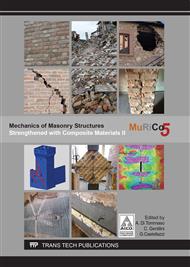p.406
p.414
p.423
p.431
p.440
p.448
p.456
p.465
p.472
Structural Health Monitoring of a Historical Masonry Bell Tower Using Operational Modal Analysis
Abstract:
This paper addresses the modal and structural identification of the historical masonry bell tower of Ficarolo, in Italy. After the seismic sequence of May 2012, the tower reported a serious damage pattern. Retrofitting interventions were designed and they mainly consisted in the rebuilding of cracked zones and the strengthening of masonry walls with carbon bars embedded in the masonry with epoxy resin. Afterwards, a continuous dynamic monitoring system has been installed on the tower. From the recorded structural response under ambient excitation, the dynamic characteristics of the tower are identified using Operational Modal Analysis techniques. Results of the first months of continuous monitoring are presented in this paper. Moreover, in order to analyse the evolution of the structural behaviour, the effect of changing temperature on the identified natural frequencies is investigated. The experimental modal parameters are also used to identify the elastic modulus of the reinforced masonry through the calibration of a Finite Element (FE) model of the tower. In addition, the influence of the soil-foundation system on the structural behaviour is evaluated. The calibration procedure is performed adopting an improved surrogate-assisted evolutionary strategy. The calibrated FE model can be adopted to simulate the structural response to far-field earthquakes. Moreover, the monitoring system can give valuable information on the structural behaviour and the structural health in the case of seismic events.
Info:
Periodical:
Pages:
440-447
Citation:
Online since:
July 2017
Authors:
Price:
Сopyright:
© 2017 Trans Tech Publications Ltd. All Rights Reserved
Share:
Citation:


